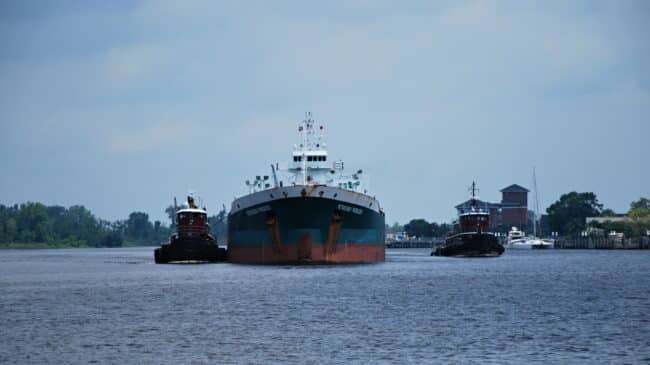Central to North Carolina’s economic output is its position on the Eastern Seaboard and utilizing that geography to its advantage through its seaports. North Carolina’s two seaports stand out as gateways through which American goods and commerce flow outward to the rest of the world. Given the projected growth of container- and bulk-shipping demand in the ports of Wilmington and Morehead City, renewed scrutiny ought to be placed on existing policies that impact the competitiveness of these ports.
This policy report, first published by the John Locke Foundation, examines the roles that both ports play in North Carolina’s economy, as well as how they are operated. Likewise, it delves into trade partners, the port’s global rankings, containerized shipping volumes, and statutory impacts on the ports. Finally, it provides recommendations for the North Carolina General Assembly to consider pursuing to keep the Port of Wilmington and Port of Morehead City growing.
Here are some of the areas highlighted in this paper.
The Importance of North Carolina’s Seaports
- The Port of Wilmington serves as a critical exporter not only for North Carolina but also for the United States at large. While the average U.S. port exports only 41% of the goods that go through it, the Port of Wilmington exports 52%, bringing American goods to foreign markets.
- The Port of Morehead City is critical to Norfolk Southern’s intermodal operability with a direct connection to the railway. Likewise, despite not having containerized cargo capacity, the port still fills an important niche for chemical products and bulk shipping.
- Together, North Carolina’s ports generate $16.1 billion in economic output for North Carolina.
COVID-19 Resilience
- Both the Port of Wilmington and the Port of Morehead City have continued to grow even through COVID-19’s peak and look to continue growing.
- Both ports could accommodate waterborne traffic diverted away from congested West Coast ports.
- Both ports have shown signs of growth since then, showing that their COVID-19 resilience was not an outlier but a trend.
Continued Need for Capacity Expansion
- Capacity at both ports is extremely limited, especially warehouse capacity. The North Carolina Ports Authority reported that 75% of warehouse capacity was being used. In Morehead City, it’s closer to 100% capacity utilization.
- In the past, the current capacity for containerized cargo in the Port of Wilmington has been sufficient to promote growth; however, vessel dwell times for container ships peaked in 2022, necessitating more capacity, especially in light of demand projections.
- Capacity expansion projects often require large amounts of capital upfront. While the state legislature has provided this capital in the past through General Fund appropriations, it may be wise to find alternative sources to put less strain on taxpayers in North Carolina.
State and Federal Policies Impacting Continued Port Growth
- Dredging and navigational improvements to accommodate neo-Panamax vessels are an expensive ordeal due to federal restrictions on the nationalities of available dredges.
- Consistent influxes of federal dollars to supplement in-state funds provide a means to continue expansion and make capital projects more easily affordable. Likewise, the North Carolina legislature’s annual appropriations may help, but there are alternative means of funding and financing available that do not leverage taxpayers’ wallets.
- Management of both the Port of Wilmington and the Port of Morehead City under the North Carolina Ports Authority may help with resource distribution but can make port-by-port analysis harder.
- North Carolina law requires that the North Carolina Ports Authority develop containerized cargo shipping capability at the Port of Wilmington and the Port of Morehead City, but only the former offers the service.
Solutions to Enable Continued Growth and Lower Costs
- Public-private partnerships (P3s) provide a new and innovative source of capital for needed capacity improvements, as well as a delivery method that does not punish taxpayers for missed deadlines and cost overruns.
- Federal-level policies have a drastic impact on the costs of dredging and should be brought to the attention of North Carolina’s congressional delegation.
- Likewise, federal grant requirements’ complexity may require waivers for new port assets, such as dock cranes. Learning to navigate these grant requirements can save the Tar Heel State time in the future, should the state seek alternate means of capital funding.
- Antiquated laws requiring the Port of Morehead City to develop containerized cargo capacity alongside the Port of Wilmington needlessly stretch Morehead City’s capability and force the two ports (currently run as two assets of one government-owned business) into competition.
- Contracting out the existing services offered at ports can help lower the overhead costs of day-to-day operations for the North Carolina Ports Authority.
Full policy brief—Gateway to the world: A dive into North Carolina’s ports

